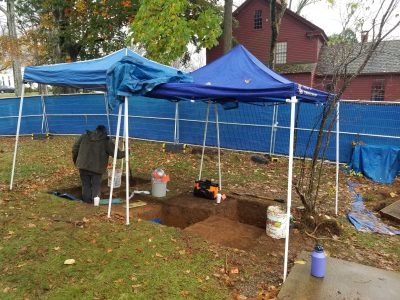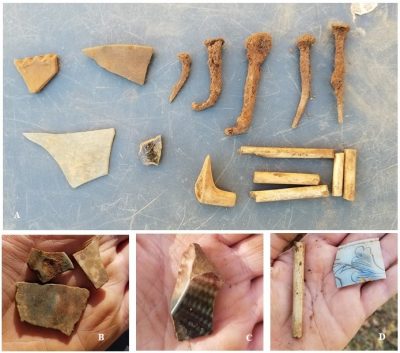In the fall of 2020, the Office of State Archaeology (OSA), with the assistance of volunteers from FOSA, completed a small archaeological excavation at the Prudence Crandall Museum in Canterbury (Site 22-16). We excavated a 9m2 area in the yard south of the house in the location of a planned drainage feature that will be installed as part of ongoing renovations.
The Prudence Crandall Museum is a National Historic Landmark and a State Archaeological Preserve. Land records indicate that there was a house and shop on the property in the second half of the 18th century, although those structures were probably demolished around the turn of the 19th century. The current house on the property was built ca. 1805 by Luther Paine, but the museum’s period of significance relates to the occupancy of Prudence Crandall, a Quaker teacher who ran a school at the house for “young ladies and little misses of color” between 1832 and 1834. Crandall’s students came from Connecticut, Rhode Island, Pennsylvania, and New York, and her school was the first academy for young African-American women in New England. The school faced immediate backlash and local people resorted to legal and physical intimidation in an attempt to destroy it. A law, known as the “Black Law,” was passed in May of 1833 which made it illegal to educate African-American students from out of state and local vigilantes terrorized Prudence Crandall and her students with a series of violent attacks. Finally, in September of 1834, Crandall closed the school and sold the house. The property changed hands several times between 1834 and 1969, when the last private owners of the structure sold it to the state of Connecticut. The house opened as a museum in 1984, a tribute to Connecticut’s State Female Hero and brave young women who risked their lives to attend the school.
Previous archaeological work was carried out on the property in the 1970s and 80s, as it was being renovated as a museum, and other small projects were also conducted prior to maintenance activities over the last 40 years. The 2020 excavations focused on the South yard, a few meters from the house. Our 9-meter excavation block encountered gravely soils and evidence of extensive landscaping in the yard. The upper soil layers contained a mix of of 18th-20th century artifacts, including whiteware, pearlware, creamware, redware, machine-cut and wire nails, window and bottle glass, coal, and other materials. On the west wall of the block, near the old access ramp, we found a feature that extended from about 10 to 60cmbs. This feature appeared to be a large post hole that was filled with cobbles and dark, organic soil, brick fragments, and small fragments of ceramics and glass.
The most intriguing aspect of the excavations was the discovery of a deeply buried, irregular deposit of grayish brown silty soil with ash and charcoal flecking the southwestern corner of the block. The ashy gray soil was encountered at about 30cmbs below surface in the western corner of the block, but dipped down to the east, petering out at about 60-70cmbs in the middle of block atop the bedrock. This layer was rich in artifacts, most of which date to the 18th century The recovered materials included English white salt-glazed stoneware (c. 1720-1770) and debased scratch blue stone ware (c. 1760-1795), Whieldon ware (c. 1740-1775), creamware (1762-1820), hand-wrought nails, glass, an English half penny from 1749, and an exceptionally large number of kaolin pipe stem and bowl fragments; over 80 stem and bowl fragments were recovered from this stratum in one 1m-x-1m unit. Many of the ceramic sherds recovered from the ashy layer appeared to have been burnt. This soil may represent a fire-place cleaning episode or the result of a dismantled chimney, perhaps from the demolition of the 18th-century house that stood on the property before Luther Paine built the existing structure.
2020 Excavation Block

Pit feature filled with cobbles

18th-century artifacts recovered from the gray ashy soil layer
